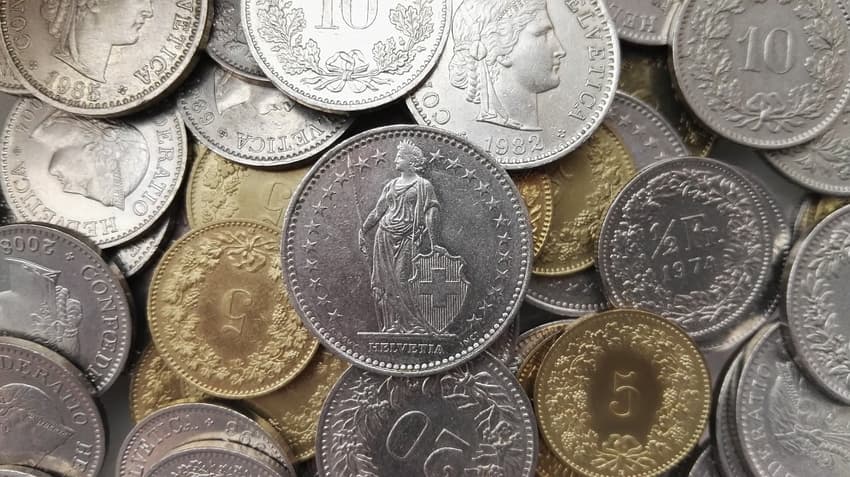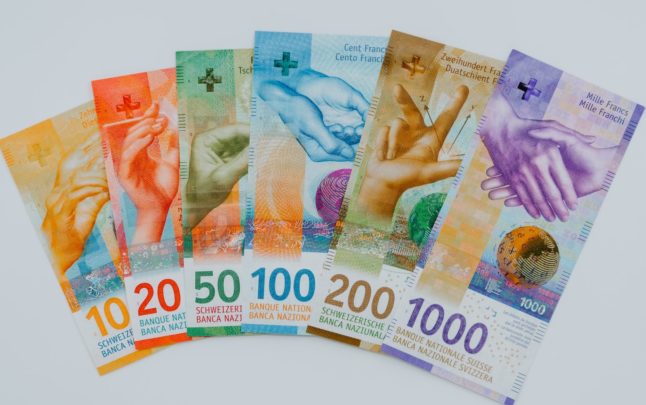The seven things you should know about Swiss money

In many people’s minds, money is synonymous with Switzerland. Whether it’s because of the country’s high cost of living or the aura of mystery (and various myths) surrounding its banks, the fact is that the franc is an interesting currency.
As far as most people are concerned, money is, well, money, and the more of it the better.
But have you ever wondered, when holding a Swiss coin or a banknote, what is the full story behind it?
If not, we have some answers for you.
A franc wasn’t always Switzerland’s main currency.
You’d better sit down for this: in the Middle Ages, people in Switzerland used to pay with fat men, horses or cornutos (horned creatures).
Okay, fat men, horses and cornutos weren’t actually physically traded in commercial transactions; rather, coins representing their images were.
Later, each canton in Switzerland had its own currency: ‘batzen’ in Bern, ‘schillings’ in Glarus, and ‘angsters’ in Zug.
The franc has only been the single national currency since 1850, introduced two years after Switzerland, as we know it today, was founded in 1848.
If you have money to burn, you can do so.
It is often said that rich people have money to burn.
But regardless of whether you are wealthy or not, you can safely burn your francs and be none the worse for it.
That’s because at the Swiss National Bank (SNB), there are experts specialised in dealing with burned (or generally damaged) banknotes.
They will be exchanged, but only under certain conditions: at least half of the note must be undamaged and its serial number must be clearly visible.
So just be careful not to burn your candle, um, money, at both ends.
Swiss franc is the only currency in Europe (other than the euro) that is used in more than one country.
Yes, that’s true: Swiss franc is also the official currency of Liechtenstein.
Initially, the tiny principality, which is wedged between Austria and Switzerland, used Austrian krone.
After World War I, however, as krone devalued, Liechtenstein decided to switch.
According to Swiss National Museum, “people were tired of the massive deprivations of the post-war period, and a veritable black economy based on the Swiss franc gradually arose. As far as possible, only hard Swiss francs were now accepted in payment for goods and services.’No one wants to accept kroner as payment anymore; everyone wants francs,’ the Volksblatt [newspaper] stated laconically in March 1920."
That may also be the reason why people in Liechtenstein speak Swiss German. In fact, the similarity between the two countries had confused even the Swiss army:
Swiss history: How the army attacked Liechtenstein three times — by mistake
Swiss banknotes are waterproof
When Switzerland began to launch its new — ninth — generation of banknotes in between 2016 and 2018, it made sure its banknotes were not only each brightly coloured, but also waterproof.

Bright, waterproof francs. Photo: Claudio Schwarz un Unsplash
There is no explanation as to why the new paper money wasn’t made fireproof as well (see above), but at least it won’t lose its value in the rain.
The 1000-franc bill is among the world’s most valued
The 1000-franc banknote has the second-highest value in the world (only Brunei’s B$10,000 note is worth more than the Swiss 1,000-franc note).
According to SNB, there is around 48.6 billion francs in circulation in the form of 1,000-franc notes — that’s a lot of money and a lot of notes floating around.
READ MORE: OPINION - Why Switzerland needs to scrap the fabled 1,000 franc note
 Second-most valued banknotes in the world. Photo: Pixabay
Second-most valued banknotes in the world. Photo: Pixabay
This is how much all the Swiss coins weigh (prepare to be surprised)
If you gather all the Swiss coins currently in circulation in Switzerland — well over 5 billion of them — their total weight (28,000 tonnes) will be equivalent to 4,000 elephants or 200 blue whales.
And if all these coins were to be stack one on top of another, their height (9,000 metres) would be twice as tall as the Matterhorn.
The oldest Swiss coins in circulation date from the 19th century
The 10-centime coins minted in 1879 are still in circulation today — and you can still pay with them.
On the other hand, the 1 and 2-centime coins are no longer used (the smallest denomination being 5 cents), and you can’t exchange them.
As the SNB put it, the bank “does not deal in worthless coins.”
READ MORE: ‘Cash is freedom:’ Why do the Swiss love coins and banknotes so much?
Comments
See Also
As far as most people are concerned, money is, well, money, and the more of it the better.
But have you ever wondered, when holding a Swiss coin or a banknote, what is the full story behind it?
If not, we have some answers for you.
A franc wasn’t always Switzerland’s main currency.
You’d better sit down for this: in the Middle Ages, people in Switzerland used to pay with fat men, horses or cornutos (horned creatures).
Okay, fat men, horses and cornutos weren’t actually physically traded in commercial transactions; rather, coins representing their images were.
Later, each canton in Switzerland had its own currency: ‘batzen’ in Bern, ‘schillings’ in Glarus, and ‘angsters’ in Zug.
The franc has only been the single national currency since 1850, introduced two years after Switzerland, as we know it today, was founded in 1848.
If you have money to burn, you can do so.
It is often said that rich people have money to burn.
But regardless of whether you are wealthy or not, you can safely burn your francs and be none the worse for it.
That’s because at the Swiss National Bank (SNB), there are experts specialised in dealing with burned (or generally damaged) banknotes.
They will be exchanged, but only under certain conditions: at least half of the note must be undamaged and its serial number must be clearly visible.
So just be careful not to burn your candle, um, money, at both ends.
Swiss franc is the only currency in Europe (other than the euro) that is used in more than one country.
Yes, that’s true: Swiss franc is also the official currency of Liechtenstein.
Initially, the tiny principality, which is wedged between Austria and Switzerland, used Austrian krone.
After World War I, however, as krone devalued, Liechtenstein decided to switch.
According to Swiss National Museum, “people were tired of the massive deprivations of the post-war period, and a veritable black economy based on the Swiss franc gradually arose. As far as possible, only hard Swiss francs were now accepted in payment for goods and services.’No one wants to accept kroner as payment anymore; everyone wants francs,’ the Volksblatt [newspaper] stated laconically in March 1920."
That may also be the reason why people in Liechtenstein speak Swiss German. In fact, the similarity between the two countries had confused even the Swiss army:
Swiss history: How the army attacked Liechtenstein three times — by mistake
Swiss banknotes are waterproof
When Switzerland began to launch its new — ninth — generation of banknotes in between 2016 and 2018, it made sure its banknotes were not only each brightly coloured, but also waterproof.

Bright, waterproof francs. Photo: Claudio Schwarz un Unsplash
There is no explanation as to why the new paper money wasn’t made fireproof as well (see above), but at least it won’t lose its value in the rain.
The 1000-franc bill is among the world’s most valued
The 1000-franc banknote has the second-highest value in the world (only Brunei’s B$10,000 note is worth more than the Swiss 1,000-franc note).
According to SNB, there is around 48.6 billion francs in circulation in the form of 1,000-franc notes — that’s a lot of money and a lot of notes floating around.
READ MORE: OPINION - Why Switzerland needs to scrap the fabled 1,000 franc note

This is how much all the Swiss coins weigh (prepare to be surprised)
If you gather all the Swiss coins currently in circulation in Switzerland — well over 5 billion of them — their total weight (28,000 tonnes) will be equivalent to 4,000 elephants or 200 blue whales.
And if all these coins were to be stack one on top of another, their height (9,000 metres) would be twice as tall as the Matterhorn.
The oldest Swiss coins in circulation date from the 19th century
The 10-centime coins minted in 1879 are still in circulation today — and you can still pay with them.
On the other hand, the 1 and 2-centime coins are no longer used (the smallest denomination being 5 cents), and you can’t exchange them.
As the SNB put it, the bank “does not deal in worthless coins.”
READ MORE: ‘Cash is freedom:’ Why do the Swiss love coins and banknotes so much?
Join the conversation in our comments section below. Share your own views and experience and if you have a question or suggestion for our journalists then email us at [email protected].
Please keep comments civil, constructive and on topic – and make sure to read our terms of use before getting involved.
Please log in here to leave a comment.